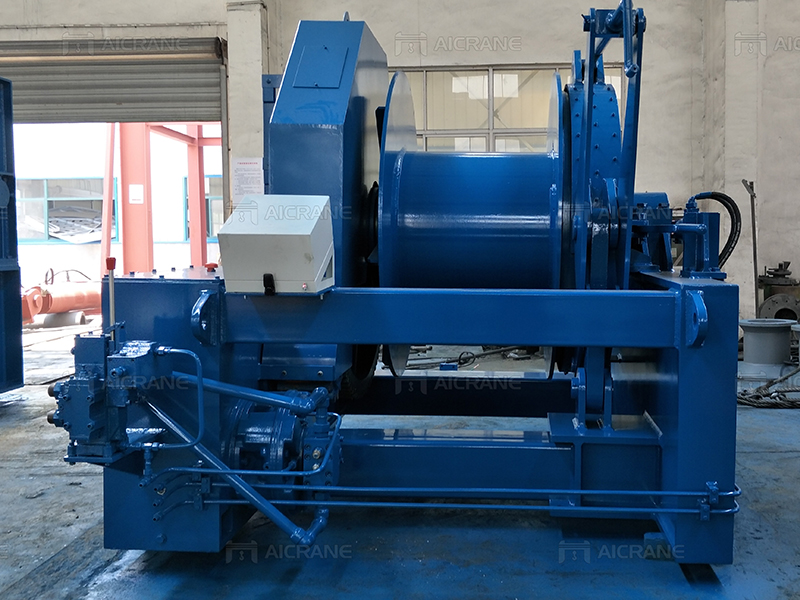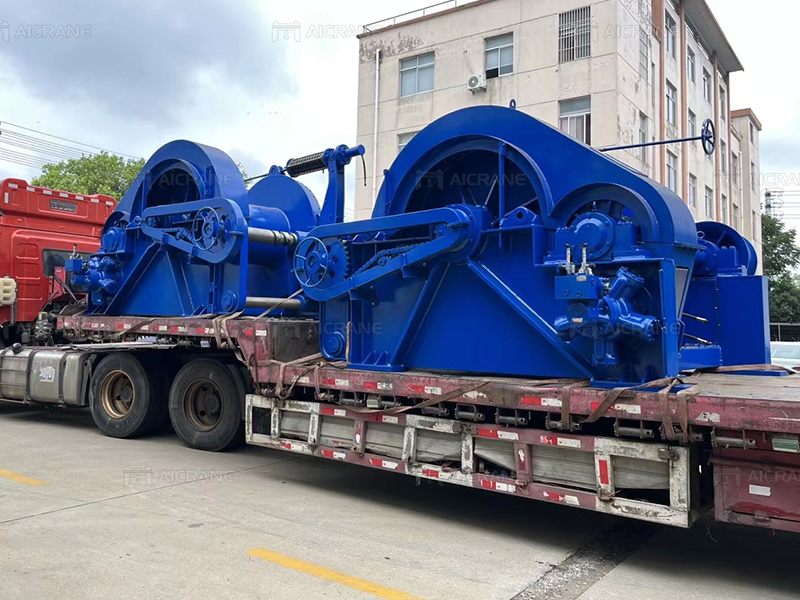The maritime industry has always relied on advanced machinery and equipment to tackle the myriad challenges that come with working on the high seas. From lifting heavy cargo to anchoring and mooring vessels, the need for reliable and powerful winches in marine applications is paramount. Among the various types of winches available, the 50-ton hydraulic winch stands out as a workhorse, providing unmatched capabilities and versatility. In this article, we’ll explore the significance of a 50-ton hydraulic winch in marine applications, shedding light on its key features, benefits, and the wide range of tasks it can perform.

The Basics of Hydraulic Winches
Before delving into the specifics of the 50-ton hydraulic winch, it’s essential to understand the fundamentals of hydraulic winches in general. Hydraulic winches are a type of winching system that utilizes hydraulic power to perform various lifting and pulling tasks. They consist of a hydraulic motor, hydraulic pump, and a winch drum. Hydraulic fluid is pressurized by the pump and directed to the motor, which drives the winch drum to wind or unwind the cable or rope. The use of hydraulic power allows for a high level of control and strength, making hydraulic winches ideal for demanding marine applications.
The Significance of 50-Ton Hydraulic Winches in Marine Applications
Unmatched Lifting Capacity
The most significant advantage of a 50-ton hydraulic winch is its remarkable lifting capacity. With a 50-ton load-bearing capacity, it can handle the heaviest loads encountered in marine operations. Whether it’s lifting heavy containers onto a ship, handling massive anchors and chains, or recovering submerged objects, this winch has the power to get the job done. The ability to lift such substantial loads is critical in ensuring the efficiency and safety of marine operations.
Enhanced Safety
Safety is a primary concern in the maritime industry, and the 50-ton hydraulic winch plays a pivotal role in promoting it. Its robust construction and high load capacity ensure that heavy loads can be handled without compromising safety. Additionally, hydraulic winches offer precise control over load movements, minimizing the risk of accidents or equipment damage. Operators can control the winch’s speed and direction, making it easier to handle delicate operations with care.
Versatile Applications
The versatility of a 50-ton hydraulic winch is another reason for its significance in marine applications. It can be used in a wide range of tasks, including anchor handling, mooring, cargo handling, and salvage operations. Whether on a cargo ship, oil rig, or fishing vessel, a 50-ton hydraulic winch can adapt to various situations, making it a valuable asset for the marine industry.
Reliability and Durability
In the harsh and corrosive marine environment, equipment needs to be rugged and reliable. A 50-ton hydraulic winch is built to withstand the challenges of sea operations. Its durable construction and materials ensure it can endure exposure to saltwater, extreme temperatures, and other environmental factors. This reliability is crucial in preventing downtime and ensuring the continuous operation of vessels and offshore platforms.
Remote Control and Automation
Many modern 50-ton hydraulic winches come equipped with remote control systems and automation features. This technology allows operators to control the winch from a safe distance, reducing the need for manual labor in hazardous or hard-to-reach areas. Remote control systems also enhance precision and safety, making marine operations more efficient and secure.

Efficient Power Transmission
Hydraulic systems are known for their efficiency in power transmission. They can generate a high amount of force with a relatively small hydraulic motor, which results in reduced energy consumption and operating costs. This efficiency is particularly valuable in marine applications where fuel costs and environmental considerations are critical factors.
Minimal Maintenance
Another significant advantage of hydraulic winches is their low maintenance requirements. The simplicity of their design and robust construction means they can operate for extended periods with minimal upkeep. Regular maintenance tasks are straightforward and generally involve basic inspections and the replacement of hydraulic fluids and seals. This translates to cost savings and reduced downtime for marine operators.
Case Studies: Real-World Applications
To underscore the significance of a 50-ton hydraulic winch in marine applications, let’s look at a few real-world scenarios where these winches have played a pivotal role:
Anchor Handling: Large cargo and passenger vessels often rely on powerful hydraulic winches to handle and deploy their anchors. These winches are instrumental in ensuring a secure and stable position for the ship while at anchor. They can handle the massive weight of anchors and anchor chains, which is essential for maintaining safety and stability.
Mooring Operations: Ports and harbors depend on hydraulic winches to facilitate mooring operations. These winches are used to secure ships and vessels to docks or buoys, ensuring they stay in place, even during adverse weather conditions. The ability to handle heavy mooring lines is vital in preventing accidents and damage to both ships and port infrastructure.
Cargo Handling: In container and cargo ships, 50-ton hydraulic winches are instrumental in loading and unloading heavy containers and other cargo. The winches are used to hoist and position cargo on the ship, contributing to the efficiency of the shipping process. They play a crucial role in optimizing turnaround times and reducing costs for shipping companies.
Salvage Operations: When objects or vessels are submerged or stranded at sea, hydraulic winches are essential tools for salvage operations. These winches can recover sunken ships, equipment, or cargo, and they provide the necessary strength and control to handle challenging salvage tasks.
Conclusion
The 50-ton hydraulic winch is a significant asset in marine applications due to its unparalleled lifting capacity, enhanced safety features, versatility, reliability, and low maintenance requirements. It is a critical tool for a wide range of tasks, from anchor handling and mooring operations to cargo handling and salvage missions. With its robust construction and advanced control systems, it ensures the efficient and safe operation of vessels and offshore platforms in the demanding marine environment.
As technology continues to advance, the role of hydraulic winches in marine applications is likely to expand further, offering even greater efficiency and capabilities. The significance of these hydraulic marine winches in the maritime industry is undeniable, as they enable the safe and efficient execution of tasks that are essential for global trade, transportation, and marine operations.